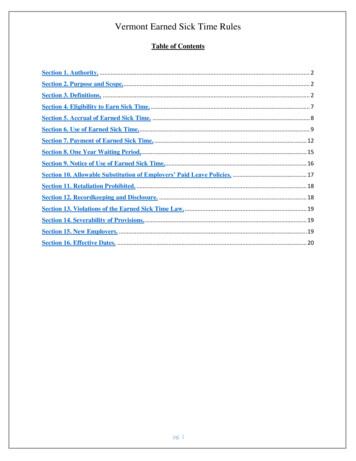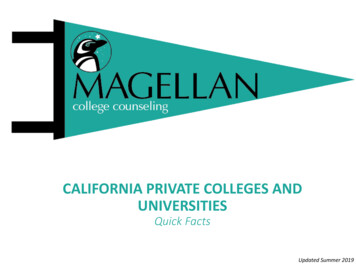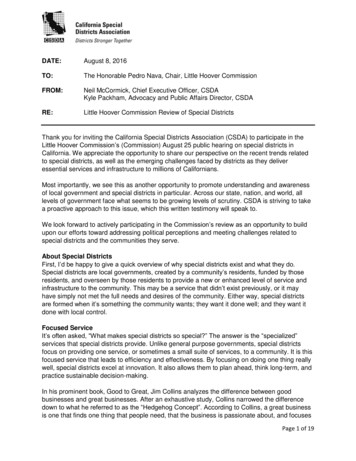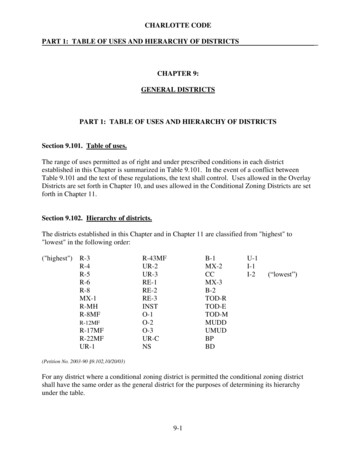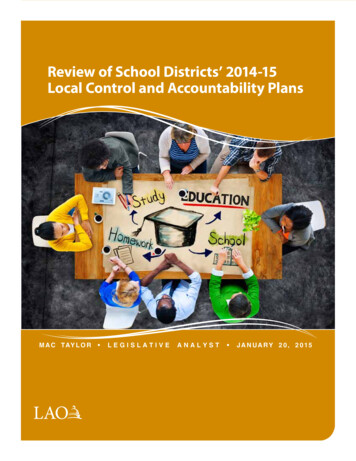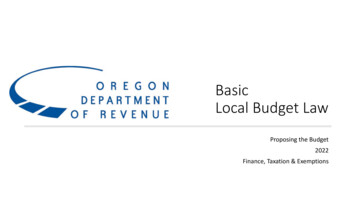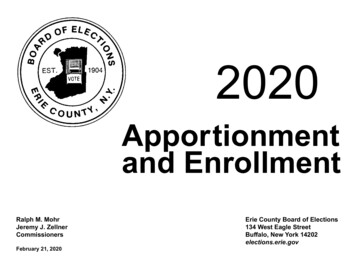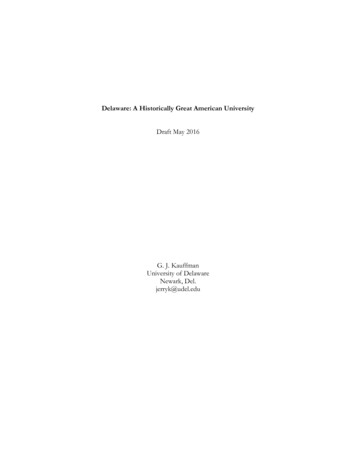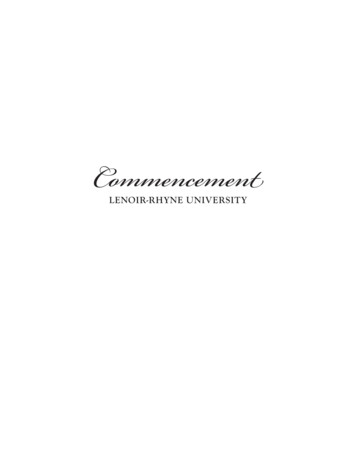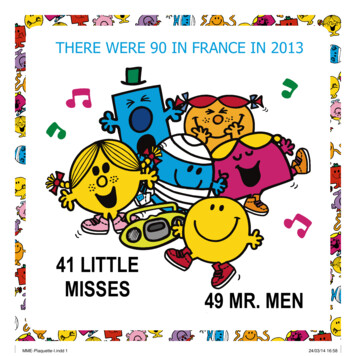
Transcription
MODERN BANDDistricts, Collegesand Universities1
ContentsSchool Districts that offer Modern Band 3Community College Modern Band SyllabiBergen Community College 8Undergraduate Modern Band SyllabiUCLA 10NYU Steinhardt 11University of Florida 13California State University Long Branch 15Eastern Washington University 18Ithaca College 21Stetson University 22Florida International University 23San Francisco State University 27Kean University 29Lebanon Valley College 31Montclair State University 35Slippery Rock University 36Indiana University of Pennsylvania 38University of Kentucky 40Drake University 41Graduate Modern Band SyllabiUniversity of South Florida 432
Example School Districts that3
K-8 Modern Band, 9-12 Modern Band Regular and Modern Band HonorsRS1 Modern Band (960101R)The major emphasis of this course is to develop student achievement through the exploration of a modernband ensemble. The course will introduce the skills necessary to perform on electric guitar, acoustic guitar,electric bass, keyboard, drums, vocals and technology. With an emphasis on the music styles of the last 50years, many of these will be discussed, demonstrated and performed by the students. The course will alsofoster peer to peer development in the band setting while encouraging each band to perform cohesively asa single unit. Students in Modern Band will also be introduced to the art of Composition and Improvisation.End of term projects will culminate with each student having their song performed by the ensemble.HS1 Modern Band (960101H)The major emphasis of this course is to build student achievement through a modern band ensemble.The course builds the skills necessary to perform on electric guitar, acoustic guitar, electric bass, keyboard,drums, vocals and technology at an intermediate to advanced level. With an emphasis on the musicstyles of the last 50 years, many of these will be discussed, demonstrated and performed by the students.The course will also foster peer to peer development in the band setting while encouraging each band toperform cohesively as a single unit. Students in Modern Band will also focus on Composition, both as anindividual and group, and Improvisation. End of term projects will culminate with both solo and group ensemble performances.K-12 Modern Band Course DescriptionModern Band focuses on a repertoire of popular music such as rock, pop, reggae, and incorporates playingand composing on guitars, basses, keyboards, drums and computers.4
K-5 Modern Band, 6-8 and 9-12Modern Band MS (321123/22)The major emphasis of this course is to develop student achievement through the exploration of a modernband ensemble. The course will introduce the skills necessary to perform on electric guitar, acoustic guitar, electric bass, keyboard, drums and vocals. Many styles of music will be discussed, demonstrated andperformed by the students. The course will also foster peer to peer development in the band setting whileencouraging each band to perform cohesively as a single unit. Students in Modern Band will also be introduced to the art of Songwriting. End of term projects will culminate with each student having their songperformed by the ensemble.Modern Band SH (321123/24)The major emphasis of this course is to develop student achievement through the exploration of a modernband ensemble. The course will introduce the skills necessary to perform on electric guitar, acoustic guitar, electric bass, keyboard, drums and vocals. Many styles of music will be discussed, demonstrated andperformed by the students. The course will also foster peer to peer development in the band setting whileencouraging each band to perform cohesively as a single unit. Students in Modern Band will also be introduced to the art of Songwriting. End of term projects will culminate with each student having their songperformed by the ensembleK-8 Modern Band, 9-12 Modern Band Non-Varsity and Modern Band VarsityModern Band Varsity (2 semesters-8510)For students who are new to playing guitar, bass, drums, keyboards and vocals. Using Contemporary Music(rock, pop, jazz and country), this course focuses on instrumental and vocal skill development as well asintroduce improvisation and composition.Modern Band Varsity (2 semesters-8512)For students who have experience playing guitar, bass, drums, keyboards, saxophone, trumpet and vocals.Using Contemporary Music (rock, pop, jazz and country), this course focuses on intermediate and advancedskill development. Pre-requisite includes instrumental students must have band or orchestra backgroundand vocalists will audition.5
K-12 Modern Band Course DescriptionThe major emphasis of this course is to build student achievement through a modern band ensemble. Thecourse builds the skills necessary to perform on electric guitar, acoustic guitar, electric bass, keyboard, drums,vocals and technology at an intermediate to advanced level. With an emphasis on the music styles of the last50 years, many of these will be discussed, demonstrated and performed by the students. The course will alsofoster peer to peer development in the band setting while encouraging each band to perform cohesively asa single unit. Students in Modern Band will also focus on composition, both as an individual and group, andimprovisation. End of term projects will culminate with both solo and group ensemble performances.Johnson City High SchoolModern Band 1 introduces the skills necessary to play electric guitar, acoustic guitar, electric bass, keyboard,and drums. This course examines a variety of contemporary musical styles including, but not limited to, pop,rock, reggae, hip hop, and jazz. The course fosters peer to peer development in the band setting while encouraging each band to play as a single unit. This course is open to all students and no previous musical experienceis necessary.Modern Band 2 is designed for students who have some experience playing guitar, bass, drums, and/or keyboards. This course examines a variety of contemporary musical styles including, but not limited to, pop, rock,reggae, hip hop, and jazz. Students in Modern Band 2 will also be introduced to the art of songwriting andcomposition. Enrollment in this course requires the signed consent of the instructor or music coordinator.6
Introduction to Modern BandIntroductory class and small ensemble instruction on Guitar, Bass, Drums, Keys, Vocals and Music Technology,focusing on 20th and 21st century popular music instrumentation and repertoire with emphasis on performance, creativity, and ensemble participation.Modern Band Ensemble- Levels I, II, III, IVPerformance ensemble class for developing an experienced musicians incorporating 20th and 21st centurypopular music and instrumentation.7
MUS-120/220/221/222Pop/Rock EnsembleDr. Bryan Powelliteachmusic@gmail.comNo prerequisitesWednesdays 5:10-7:05 p.m. (001), 7:15 – 9:10 p.m. (002), W-226 (West Hall Recital Hall)COURSE DESCRIPTION:Pop/Rock Ensemble I/II/III/IV requires students to study and to perform in a variety of popularmusic styles. Special attention will be given to the development of creative skills and ensembleparticipation. Students are expected to participate in concerts for college ceremonies andfunctions.LEARNING OBJECTIVES:As a result of meeting the requirements of this course, students will be able to:1. D emonstrate foundational techniques of popular musicianship, playing both by “ear” andby using notational tools such as lead sheets, chord charts, and tablature.2. A nalyze the basic components of popular music compositions and arrangements, includingsong structure, chord progressions, melodic and rhythmic patterns, playing the “groove,”and arrangement techniques.3. Explain the similarities and differences between several popular music styles.4. D emonstrate professional skills in utilizing music technology, including microphonetechnique, tone control, amplified instruments, and live sound reinforcement.4. A rticulate the musical legacy of historical popular musicians, discussing their musical andsociocultural importance.5. D emonstrate the ability to create and perform music together with other musicians inrehearsals and concerts.6. E xhibit the professionalism and attitude required to foster a creative and productivelearning environment.7. E xplain the importance of popular music and Modern Band instruction in educationalcontexts.MATERIALS:There are no required textbooks for this course. Musical charts will be distributed by instructoror can be obtained online. Other instructional materials may be suggested to individualstudents to facilitate the development of popular musicianship.It is suggested that students supply their own instruments and accessories. If you are unable toobtain an instrument for the class, please let Dr. Powell know and he can lend you one for theduration of the course. Drums, percussion, keyboards, and amplifiers will be supplied by thecollege. Each student is expected to purchase a black notebook or folder to keep their assignedmusic. This music can be taken home for practice. In addition, it is recommended that studentsutilize the recording function on their phones or other devices to record portions of the classfor home review.8
RECOMMENDED RESOURCES:Larry Baione and the Berklee Faculty. Berklee Practice Method: Get Your Band Together!Boston: Berklee Press, 2001. (Books are available for bass, drum set, keyboard, voice,vibraphone, alto sax, tenor sax, trombone, trumpet, and violin.)Modern Band Charts for Modern Band Ensemble- Available for free download at - BandCharts.pdfEVALUATION:Attendance/Participation 40% Musical Evaluations 40%Professional Attitude and Rehearsal Conduct 20%A 90-100B 86-89B 80-85C 76-79C 70-75D 60-69F below 60W official withdrawalIncomplete given only with the permission of the instructorCOURSE REQUIREMENTS:Students are expected to practice the material during the week. The course will includemidterm and final musical evaluations based on rehearsals, concert performances, andrecordings. Each student is expected to improve his or her musicianship and improvisationalskills each semester. In addition, students will be evaluated by the following: Attendance / Class Participation: To get full credit for Attendance / Participation you shouldcome to all classes, complete all listening and writing assignments and pay special attention tothe “ensemble etiquette guidelines.” Since absence or tardiness disrupts the entire ensemble,unexcused absences or tardiness will not be tolerated and will result in a lower grade as wellas being barred from performing in the concert. All students are expected to assist withequipment setup and testing. Students will be assigned these tasks on a rotation basis. Campus Performances: In December, the BCC Pop/Rock Ensemble will put on a final concert.Friends and family are invited to this event. Participation in this event is mandatory. You areexpected to be present for the entire event. Off-Campus Performances: The ensemble (or selected members of the ensemble) mayhave the opportunity to perform at off-campus venues. More information about theseperformances will be provided later.ZERO TOLERANCE POLICY:The instructor reserves the right to ask any student, who is behaving in an inappropriatemanner, to leave the room. If a student is asked to leave two times within the semester, theinstructor asks that they meet with a school counselor before returning.9
EDUC 330A – Observation &ParticipationEDUC 360A - Novice SeminarInstructor: Frank HeuserOffice: 2637 Schoenberg HallOffice Hours: Tuesday 3-4, by appointmentPhone: 310-206-8297email: fheuser@ucla.eduCourse Description:These courses provide the first introduction to field experiences in music education. Studentsteach in an elementary setting (violin or guitar using Modern Band instructional materialsEDUC 330A), explore pertinent literature about teaching, assess their progress as teachers, andreflect on their growth as future professional educators (EDUC 360A - Novice Seminar).Objectives of the Course: These courses have the following objectives:1. Students will be able to demonstrate and teach the instruments and musical concepts,manage classes of beginning instrumentalists, and understand and apply the pedagogicalprinciples studied.2. Students will be able to apply and modify as necessary a prescribed curriculum inbeginning violin.3. Students will use materials provided by Little Kids Rock to create a curriculum for popularguitar for use in the fourth grade.4. Students will create meaningful lesson plans for use in the different class settings.5. Students will become increasingly adept at modifying plans in real-time to meet theevolving needs of a given teaching situation.6. Students should learn to identify and describe major concepts and theories in the field ofmusic education as they apply in the teaching setting.7. Students should be able to critically evaluate literature in the field of music education,create a thesis and write a research paper to support that thesisTexts: Readings as assignedLittle Kids Rock (2014) Guitar Song Book and Teacher’s Manual (supplied by LKR).GradingEDUC 330A (Observation &Participation) is a pass/no pass courseEDUC 360A (Novice Seminar) is graded as follows:Video reflections 30%Readings & reflections 30%Teaching progress 40%Course ScheduleSeminar meets weekly TBA.Exact course schedule is determined by the classroom teachers at each school and is modifiedbased of changing conditions at the school site (field trips, local school holidays, etc.).10
Popular Music Methods:Instrumental Materials & Techniquesin Music EdNEW YORK UNIVERSITYTHE STEINHARDT SCHOOL OF CULTURE, EDUCATION, AND HUMAN DEVELOPMENTDEPARTMENT OF MUSIC AND PERFORMING ARTS PROFESSIONSSummer 2015Instructor: Dr. Bryan PowellCourse LogisticsDates/Times:Credit Hours:Location:July 13-16, 5:15 p.m. – 8:15 p.m.1Room 1101, Steinhardt- 35 W. 4th St.COURSE DESCRIPTION:Exploration into popular music pedagogy through performance, composition, improvisation,informal learning, and Music Learning as Language Learning theory.PREREQUISITES:Music education undergraduate or graduate standing or consent of the Department.COURSE FORMATThis course will discuss popular music pedagogy and curriculum, starting with the key tenetsof Informal Learning, Composition, Improvisation, Approximation, Scaffolding, and Creating aSafe Space. These will be demonstrated through interactive lecture, performance, and groupinteraction on guitar, bass, drums, keyboards, technology, and vocals.COURSE MATERIALSMaterials from this course will include a mix of scholarly and practical articles and bookchapters, in addition to curricular resources created by Little Kids Rock. In addition, the classwill cover basics of different rock instruments, including guitar, keyboard, bass, and a drum setbeing provided for class study. All course materials, including instruments, will be provided forthe students. It is not necessary to own a guitar to participate in this course.COURSE OBJECTIVES AND STUDENT OUTCOMESAt the end of the course, students will be able to:1. Understand the key components of popular music pedagogy2. Demonstrate familiarity with popular music education theories such as formal and informallearning styles, learning through familiar material, and the value of all music.3. Demonstrate some proficiency on a variety of rock band instruments and styles4. Demonstrate a well grounded knowledge of educational concepts and preparation in orderto implement different teaching styles in the classroom5. Demonstrate comfort teaching improvisation, composition, and group participation in a rockband setting.11
6. Explain the utilization and importance of popular music education a school setting.GRADINGMidterm Composition 30%Final Presentation 30%Response Journals 30%,Participation 10%Course OutlineSession #1Date: 7/13/15Topics: Review Syllabus including midterm performance and final presentation dates andrequirements.Intro to Popular Music Pedagogy Introduce students to Modern Band Core values with emphasis on safe space Beginning and opening jams: immediate music makingBeginner Guitar Simple and necessary techniques: holding the guitar/using a pick Understanding frets and strings Introduce reading chord charts Easy one finger chord charts Composing and performing one finger songs as a classGetting Started on Keyboard Keyboard chords (one shape system) Using jam cards to play scales and progressions Composing simple chord progressions Understanding short hand finger patternsJournal EntriesSession # 2Date: 7/14/15Topics: Sharing Sample Warm Up exercisesRhythm Section: Bass and Drums Drumming anywhere: playing the backbeat Introducing the electric bass: History and function Jamming along with bass “grooves”The Full Band Experience Putting together the pieces of the Modern Band using simple charts Rotating instruments between students Sound checking and balancing Setting up the modern band in a classroomMusic As A Second Language Music as a Second Language Pedagogy Stages of language development Understanding the affective filterSongwriting Understanding the process of writing a song Ways to make composition approachable for students Compose a song as a class12
Time to Work on Group Songs/ Journal EntriesSession # 3Date: 7/15/15Topics: Mid Term- Group PerformanceBeginner Pedagogy Classroom techniques to make music more approachable Sticker technique on guitars/basses Dividing up the role of the drummerImprovisation The famous two note solos Introducing the pentatonic shape on guitar Connecting the pentatonics to the keyboardsGroup work on Final ProjectsSession # 4Date: 7/16/15Topics:Advanced Guitar Techniques Moveable chord shapes: barre chords and power chords Articulation on guitar: slides, bends, pull-offs and hammer-ons The history of guitar notation and the power of tablature Designing your tone: demystifying the endless options on guitar amplifiersProject Work Time Students will be given the class time to work on their final presentation. This presentation willinclude: summary of popular music pedagogies, demonstrating knowledge of content andpedagogy, demonstrating knowledge of resources, and designing student assessmentsFinal Presentations Presentation of Final Projects Reflection13
MUE 2040: Introduction to MusicEducationDr. Megan M. Sheridan Credits: 2Email: msheridan@arts.ufl.edu Class meeting time: MW Period 3Office: MUB 356 (9:35-10:25am)Office Hours: TW pd. 4 10:40am-11:30am; other times available by appointmentGraduate Teaching Assistant: Ms. Melissa LifeEmail: mrlife@ufl.eduCourse Description:An introductory course for candidates for the Bachelor of Music in Music Education thatconcentrates on the role and function of music education and music teachers.Objectives of the Course:Through full participation in this course, students will: Describe the role of public school music teachers and the status of public school musiceducation. Articulate how students learn and describe major learning theories. Describe student characteristics in diverse populations common in music classroomcontexts. Demonstrate growth as a pre-service music educator through in class teaching experiencesand discussions. Demonstrate musical skills through singing and playing classroom instruments, includingukulele and Orff instruments. Identify and describe music teaching methods in terms of historical and current applicationsin music classrooms, including Kodály, Orff, Dalcroze, and Modern Band. Write professionally about topics in music education using APA style.Textbooks Required:Raiber, M. & Teachout, D. (2014). The journey from music student to teacher: A professionalapproach. New York: Routledge. ISBN: 9780415806855Strongly Recommended:American Psychological Association. (2010). Publication Manual, 6th ed. APA. ISBN:9781433805615Required Materials:Video camera (smartphones and iPads are acceptable)Required Membership:All music education students must join the student chapter of the National Association forMusic Education (NAfME). You must attend the monthly meetings. Attendance is taken atmeetings. Information on how to join and the meeting schedule will be given during the firstweek of classes.14
MUS 487A Emerging Methods inMusic EducationCalifornia State University Long BeachREQUIRED TEXTS and MATERIALS:Music education with digital technology. Finney, J. & Burnard, P. New York: Continuum. 2010.Music, informal learning and the school: A new classroom pedagogy. Green, L. Burlington, VT:Ashgate Publishing. 2008.Using technology to unlock musical creativity. Watson, S. New York: Oxford University Press.2011.Music as a second language & the modern band movement. Wish, D., Speicher, C.,Zellner, R., & Hejna, K. Verona, NJ: littlekidsrock.org. 2013.COURSE DESCRIPTION:This course examines emerging pedagogical methods for music educational settings outside ofthe traditional general, band, choir and orchestra. Letter grade only (A-F).STUDENT LEARNING OUTCOMES:Students will:A. Identify appropriate skills, teaching strategies, and sequence of concepts for developingstudents’ musical independence.B. Select music literature and materials appropriate for students’ capabilities and musicalmaturity, including adaptation if warranted.C. Identify appropriate instructional strategies for exceptional students.D. Identify instructional strategies for teaching popular music history and theory.E. Identify techniques for developing students’ creative musical skills (e.g., improvisation,composition, listening skills, sight reading, performance skills).F. Identify appropriate organization of rehearsals and classroom activities to include musichistory, music theory, listening skills, performance, and sight reading as integral parts ofinstruction.G. Identify the relationships between music, the others arts, and disciplines outside the arts.H. I dentify factors in creating a music curriculum that provides a balance of musicalexperiences for all students.I. Select teaching strategies that motivate and promote students’ musical growth,independence, and creativity.J. Identify techniques for assessing and evaluating student progress.K. Select strategies for implementing technology in music instruction.L. I dentify media resources and technology (e.g., sound recording and reproduction systems,visual aids) for instructional purposes.M. Select acoustic and electronic instruments (e.g., pianos, synthesizers, guitars, keyboards,tablets) for instructional purposes.N. I dentify and select appropriate computer hardware and software for both administrativepurposes and instructional applications.O. I dentify resources available through professional organizations, music industry, andpublications.P. Identify procedures for student selection, recruitment, and retention, including feederschools and placement in appropriate music courses.15
COURSE REQUIREMENTS:Discussion Board and QuestionsA. T here will be a weekly discussion board. You will be required to contribute to the discussionboard before the start of the next class session. You will need to complete an initial post,consisting of: a) topic you liked/agreed with from the reading, or b) topic you disliked/disagreed with from the reading. * You must also rely to someone else’s post. All responsesmust be at least 50 words.B. Each student will be responsible for generating two multiple-choice questions (with fourpossible answers) before the start of class. Questions are to be drawn from the readingsfor that week, and vary in difficulty level.Skills DemonstrationYou will be expected to demonstrate the skills you are learning about in class. Thesedemonstrations could be in solo or ensemble form. Details will be given as each skillsdemonstration approaches.Mid-Term ExamA mid-term examination will be given, based on course readings and my lectures. Questions willbe drawn from questions you write for the class (see above), and from questions I prepare foryou.Final PaperWrite a 10-page paper on some aspect of the emerging methods learned in this class, i.e.,informal learning practices, creativity, peer-to-peer teaching, etc., and how it’s application canhelp attract and retain students in public school music programs.Music Practicum ProposalYou will identify and partner with other students with similar interests to select a springsemester ensemble development in either, popular music, mariachi, steel drums, or electronics.In your proposal, you will 1) identify the area of study and explain your choice, 2) identifyresearch resources, 3) identify published methods/materials, 4) provide a cost summary forclassroom materials.Attendance and ParticipationEvery course member is to be invested in course work each week, as learning in the class isenhanced by the work of each member. Student work must be turned in on time. Grades onindividual assignments and projects will be reduced by a half grade every day that they are late.GRADING POLICY:15% Discussion Board and Questions15% Skills Demonstration25% Mid-Term Examination25% Final Paper20% Music Practicum ProposalPOLICIES FOR ATTENDANCE, CHEATING, PLAGIARISM, AND SPECIALNEEDS:1. A TTENDANCE: This is a professional preparation course; therefore students are expectedto attend all classes. You cannot learn how to play/teach/problem solve strings unless youare in class. Class begins promptly at 4:00PM. Excused absences (limited to 1) include butare not limited to: illness/injury to the student; death, injury, serious illness of an immediatefamily member or the like; religious reasons (California Education Code section 89320); juryduty or government obligation; university sanctioned or approved activities. Students are16
responsible for informing the instructor of absences 24 hours in advance when possible andarranging to complete/makeup missed assignments, tests etc. insofar as this is possible. Incase of an emergency, absence will be handled one-on-one with the instructor.2. C HEATING AND PLAGIARISM: Plagiarism is defined as the act of using the ideas or workof another person or persons as one’s own (“person” may be defined as another student),without giving credit to the source. Acknowledgment of an original author or source mustbe made through appropriate references (i.e., quotation marks, footnotes, or commentary.A student who is in doubt about the extent of acceptable paraphrasing should consultthe instructor. Both quoted and paraphrased materials must be given proper citations.Cheating is defined as the act of obtaining or attempting to obtain or aiding another toobtain academic credit for work by the use of any dishonest, deceptive, or fraudulent means.Students should be aware that plagiarism and/or cheating may result in “no credit” for aparticular assignment, “no credit” for the course, or expulsion from the University. Pleaseconsult the University Catalog, p. 88, for more complete information.3. S PECIAL NEEDS: Disabled Student Services provides appropriate services for students withdisabilities including registration assistance, note-taking, sign language interpreting, reading,test proctoring, academic advising, and scholarship information. It is strongly recommendedthat students with disabilities attempt to modify their schedules, as necessary, to lessenthe impact of a disability. Students with disabilities may request to enroll in a unit loadcommensurate with their ability. Reduced unit load is defined as less than 12 units forundergraduates and less than eight units for graduates. These requests must be made toDSS prior to each semester affected. If approved, the student will be entitled to all benefits,services, and activities governing by the University accorded to full-time students.COURSE CALENDAR:Week/Topic/ReadingWeek 1 Topics:Intro/OverviewMusic EnrollmentTrendsG1 Intro to InformalLearningLKR-MBM Music as aSecond LanguageW1/2 CreativityPre-Reading emailed:Green Ch. 1 (pp. 1-10)LKR/MBM (pp 3-29)Watson Ch. 1 & 2 (pg.3-25)ActivityLKR’s Modern BandMovement – ScottBursteinEssentialQuestions1) ( Zanutto)Implications ofenrollment trends?Overview of Materials & 2) ( Green) What are theStrategies5 factors of InformalLearning?Website - MusicalFutures Overview3) ( LKR-MBM) What canmusic teachers learnLAB - GarageBandfrom EL theory?basics4) ( Watson) Identifycreative activitiesin traditional andemerging ensembles.17GenreFormatPopular MusicInstruments
MUSC 496: 08 Teaching Modern BandEastern Washington UniversityCourse: MUSC 496: 08 Teaching Modern BandSemes
Students in Modern Band will also focus on composition, both as an individual and group, and improvisation. End of term projects will culminate with both solo and group ensemble performances. . Larry Baione and the Berklee Faculty Berklee Practice Method: Get Your Band Together! Boston: Berklee Press, 2001 (Books are available for bass, drum .
